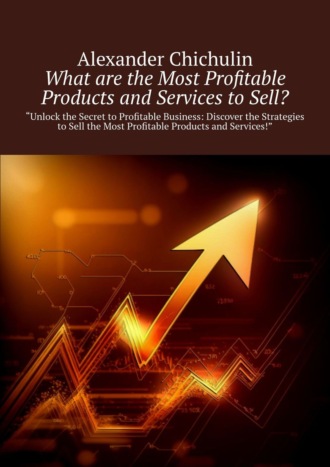
Полная версия
What are the Most Profitable Products and Services to Sell?

What are the Most Profitable Products and Services to Sell?
Alexander Chichulin
© Alexander Chichulin, 2023
ISBN 978-5-0060-0197-8
Created with Ridero smart publishing system
I. Introduction
– Purpose of the book
The purpose of this book is to provide aspiring business people with insights into the most profitable products and services to sell. The book aims to help readers identify and evaluate the potential profitability of different products and services, and provide strategies for creating, marketing, and scaling profitable businesses. By providing practical guidance and real-world examples, this book seeks to equip readers with the knowledge and tools they need to succeed in today’s competitive business landscape.
– Importance of choosing profitable products and services
Choosing profitable products and services is essential for the success of any business. Profitability is the key to sustainability and growth, as it provides the resources necessary for a business to invest in new products, expand operations, and stay competitive in the market. Profitable products and services not only generate revenue, but also contribute to the bottom line, which is essential for long-term success. By understanding the factors that contribute to profitability, businesses can make informed decisions about what products and services to offer, how to price them, and how to market them effectively. This can help businesses stay ahead of the competition, attract and retain customers, and achieve their financial goals.
– Overview of the chapters
Chapter 1: Introduction – In this chapter, the book introduces the topic of profitable products and services and explains why it’s important for aspiring business people to understand it.
Chapter 2: Understanding Market Demand – This chapter explains how to identify market trends, conduct market research, and analyze competition in order to assess the demand for different products and services.
Chapter 3: Assessing Product and Service Profitability – This chapter covers the basics of calculating costs and expenses, determining profit margins, and evaluating return on investment (ROI) to determine the profitability of different products and services.
Chapter 4: Exploring Profitable Products – In this chapter, the book explores different product categories with high profitability potential, provides examples of successful products in different industries, and offers strategies for creating and marketing profitable products.
Chapter 5: Exploring Profitable Services – This chapter is similar to Chapter 4, but focuses on service categories with high profitability potential, examples of successful services in different industries, and strategies for creating and marketing profitable services.
Chapter 6: Scaling a Profitable Business – This chapter provides strategies for scaling a profitable business, overcoming common challenges, and includes case studies of successful businesses that have scaled profitably.
Chapter 7: Conclusion – The book concludes with key takeaways from the book, final thoughts, and recommendations for aspiring business people.
I hope this gives you a good idea of what to expect from each chapter!
II. Understanding Market Demand
– Identifying market trends
Identifying market trends involves analyzing changes and shifts in consumer behavior, preferences, and needs that can affect demand for different products and services. It’s important to stay up-to-date with trends in your industry, as they can provide valuable insights into what products and services are likely to be profitable in the future. Some ways to identify market trends include conducting market research, analyzing data on consumer behavior and preferences, and monitoring the activities of competitors. By understanding market trends, businesses can make informed decisions about what products and services to offer and how to market them effectively to meet the evolving needs and preferences of their target customers.
– Conducting market research
Conducting market research is a crucial step in understanding the demand for different products and services. Market research involves gathering and analyzing data about the market, including consumer behavior, preferences, and needs, as well as information about competitors, industry trends, and market conditions. The goal of market research is to identify opportunities and challenges in the market, as well as to gain insights into customer needs and preferences.
There are several methods for conducting market research, including surveys, focus groups, interviews, observation, and secondary research (using existing data sources). Surveys can be conducted online, via phone, or in-person, and can be used to collect quantitative data about customer behavior and preferences. Focus groups and interviews involve small groups of participants who are asked to share their thoughts and opinions on a particular topic or product. Observation involves observing customers in their natural environment, such as a store or website, to gain insights into their behavior and preferences.
The information gathered through market research can be used to develop effective marketing strategies, make informed decisions about product development, and assess the potential profitability of different products and services. By understanding the market and the needs of customers, businesses can create products and services that meet the demands of the market and are likely to be profitable.
– Analyzing competition
Analyzing competition is an important part of understanding the market and identifying profitable products and services. By analyzing competitors, businesses can gain insights into their strengths and weaknesses, as well as their strategies for success. This information can be used to identify gaps in the market that can be filled with new products or services, as well as to develop strategies for differentiating a business from its competitors.
To analyze competition, businesses can start by identifying key competitors in their industry or market segment. This can be done through research online, attending trade shows, or using market research data. Once competitors have been identified, businesses can analyze their products and services, pricing strategies, marketing tactics, and customer engagement strategies. This can be done through online research, purchasing competitor products, or visiting their stores or websites.
The information gathered through competitor analysis can be used to identify areas where a business can differentiate itself from its competitors, such as through offering unique products or services, lower prices, better customer service, or more effective marketing strategies. By understanding the competition, businesses can create strategies for success that take into account the strengths and weaknesses of their competitors, as well as the opportunities and challenges in the market.
III. Assessing Product and Service Profitability
– Calculating costs and expenses
Calculating costs and expenses is a crucial step in determining the profitability of products and services. It involves identifying all the costs associated with producing and selling a product or service, as well as any other expenses that may be incurred in the process. By accurately calculating costs and expenses, businesses can determine the price at which a product or service needs to be sold to achieve profitability.
To calculate costs and expenses, businesses need to consider both direct and indirect costs. Direct costs are those that are directly related to the production or delivery of a product or service, such as materials, labor, and shipping. Indirect costs are those that are not directly tied to a specific product or service, such as overhead expenses like rent, utilities, and marketing.
Once all costs and expenses have been identified, businesses can calculate the total cost of production or delivery for each product or service. This can be used to determine the break-even point for each product or service, which is the point at which the revenue generated from sales equals the total cost of production or delivery. Beyond the break-even point, each sale generates a profit.
Конец ознакомительного фрагмента.
Текст предоставлен ООО «ЛитРес».
Прочитайте эту книгу целиком, купив полную легальную версию на ЛитРес.
Безопасно оплатить книгу можно банковской картой Visa, MasterCard, Maestro, со счета мобильного телефона, с платежного терминала, в салоне МТС или Связной, через PayPal, WebMoney, Яндекс.Деньги, QIWI Кошелек, бонусными картами или другим удобным Вам способом.











